
Private homepage – Hans-Georg Michna
Kenya travel reports: 1999, 2000, 2002, 2003, 2004, 2005, 2006, 2007, 2008, 2009, 2010, 2011, 2012, 2013-Goma, 2013, 2014, 2015, 2016, 2017, 2018, 2019
Kenya Safari Travel Plan, Kenya 1980-2000 photos
Kenya 2005
A personal travel report from Kenya in May and June 2005
Last change 2007-08-09 Copyright 2005-2023 Hans-Georg Michna
Click on the small pictures to see them enlarged, usually to 800 x 600 pixels.
Times are given in local Kenyan time in 24h format (without "am" or "pm"), i.e. 0:00 to 23:59 o'clock.
All photos are subject to copyright . If you want to reuse any photo, send me an email asking for permission, and I can send you the full-size photo, usually 1,600 x 1,200 pixels. Photos bear the copyright 2005-2023 Hans-Georg Michna.
[Still the same cameramy Panasonic Lumix DMC-FZ1-2 digital camera. Most photographs in this travel report are reduced to 800 x 600 pixels and JPEG-compressed with medium strength to make them more palatable for the web.]
The plan is to travel through Kenya with my family during the two school holiday weeks after Pentecost. After those I will stay on for another two weeks.
My own travelling checklist in michna.com/kenya.htm#Preparations and in the German version michna.com/kenia.htm#Reisevorbereitungen is again saving my soul from pre-travel stress. The method I use is to go through the checklists at least two times.
First I print the check list. During the first pass I check which items I already have and which need attention, and I make marks next to these items. Then I process the problem items, i.e. I order things, go shopping, etc.
The second pass happens the evening before I leave. It is the actual packing, again guided by the checklist. Nicest point is that I can't forget anything.
Our current, tentative plan is this: Nairobi Lake Nakuru Lake Bogoria (Hannington) Lake Baringo Samburu Nairobi Maasai Mara Nairobi. Since we don't book anything, we can change our plan at will.
The last week I was still at work in Magdeburg and drove back to Munich on Friday afternoon, even slower and more carefully than usual, so as not to risk the vacation trip. Then I packed my travelling bag on Friday evening and tried to go to bed early to get more sleep, but, as usual, didn't quite succeed.

The local flight times were Munich 6:45 8:20 Amsterdam Schiphol 10:45 20:10 Nairobi.
The alarm clocks rang at 3:30 am, and a neighbor drove us to the airport around 4:30, to arrive there at 5 am. A short night, but then we had some time to rest in the plane, particularly in the second one from Amsterdam to Nairobi, where we arrived after dark in the evening.
The lady at the check-in counter was a very poor choice. We had our luggage plus four pieces with used clothes as gifts. Normally they let you take at least 23 kg instead of the formally permitted 20, but this woman must have been in a very bad mood. She stuck absolutely to the rules and let us take only a weight below the allowed 80 kg for the four of us, so we could only take two suitcases and even had to leave a light bag that would barely have taken our luggage weight beyond 80 kg. She didn't want to understand the situation and didn't care at all. Apparently she didn't allow into her mind the thought that some people in Africa could badly need the stuff, nor the thought that we would be a lot under our weight limit on our return flight, not to mention that particularly the kids are fairly light. When I tried to explain this, she didn't listen. It was a combination counter for KLM, Alitalia, and Air France, so the airline can't be blamed.

Changing planes at Amsterdam Schiphol
After a two-hour stopover in Amsterdam we boarded the flight to Nairobi.

GPS track Munich Amsterdam Nairobi
During the first flight from Munich to Amsterdam nobody sat at a window, so there is no GPS track. The other track has, of course, some gaps because of insufficient GPS satellites or because we ate or rested and didn't have the GPS leaned against the window.
Since Kenya's time is already 3 hours later than UTC, you have to set your watch one hour later when you come from the European daylight saving time. In winter it would be two hours.
Under the equator after dark doesn't mean as late as in Europe, because the sun always rises and sets roughly at the same time, 6:30, with little more than half an hour of dawn or dusk.
My biggest worry after arrival is that the visa and immigration procedure, including long waiting lines, takes so long that our luggage would meanwhile circle the luggage belt and be vulnerable. But I learned a new trick this time.
One of the people working at the airport singled us out for V.I.P. treatment. He quickly arranged everything with the immigration counter and took the $200 visa fees from us, we didn't have to fill in the visa forms, received more or less unreadable three-month visa stamps and got waved through while everybody else was still waiting in line. People familiar with Africa will immediately understand procedures like this. (The money disappears in a pocket, rather than in the government's coffers.)
A small jeep, again a Suzuki Maruti Gypsy, awaited us at the airport.
Then there was the next incredibly unlikely surprise. On the same flight with us had been Tom, an acquaintance from the Amboseli project, where he had worked two years ago. I hadn't seen him on the plane, but then we met at the luggage belt.
He turned out to have only an unconfirmed appointment to stay for the night, so I offered him to come with us to the Aero Club. Since the receptionist had already gone home, leaving our room keys with the bar man, I couldn't reach the Aero Club on the telephone. So we took our chance, made a plan B (taxi to a hotel), then squeezed into the jeep, which was really full then, and drove off to the Aero Club.
The route bypasses the city on the south side, so it is not difficult to drive and doesn't take a long time.
We arrived at the Aero Club and were greeted by the bar and restaurant crew. There was a free single room for Tom as well, and after a few telephone calls they could get at the key, and we were all set. After a drink at the bar we went to bed and slept quite well. No surprise, we were tired.

Tom and the Michnas at the Aero Club's bar
The Aero Club is for members only and for people accompanying them, so unless you had a member with you, you would have to go to a hotel instead. A fairly good one is the Fairview Hotel. I currently don't know any low-priced hotels in Nairobi, but there are several. And there's a quite reasonable youth hostel.
In the morning we still had a few things to do. I intended to take a suitcase with used clothes to a friend, but that didn't work, because of a dead telephone number. So I left the suitcase at the Aero Club for now. First I pulled as much Kenyan money as possible, i.e. KSh 40,000, from a nearby ATM, using my Maestro (ec) card. Very nice and easy way to get cash while travelling, and the exchange rate is excellent. Then I passed by the entrance of the Nairobi National Park, which is a KWS (Kenya Wildlife Service) smart card point of issue, and loaded a sufficient amount of US$ and KSh onto the card. Finally I took some exotic brands of cheese we had brought (exotic for Kenya, anyway) to another friend and drove back to the Aero Club.
Meanwhile the rest of the family and Tom had taken their breakfast and were still sitting at the table on the open-air terrace of the club's restaurant. I took a little breakfast too, then we loaded our jeep and took off, dropping Tom at a big supermarket at Uhuru Highway on the way. He had to catch a shuttle bus to Tanzania later in the afternoon and wanted to spend his time until then to buy a few useful things.
We drove off and across Nairobi to the north along Uhuru Highway. On this Sunday morning there was little traffic, and we passed Westlands quickly.
We continued along the four lane highway towards Naivasha, but then turned onto the old road into the Rift Valley to Mai Mahiu, because is is more beautiful and because we wanted to test it again.
The drive down the escarpment was as spectacular as ever. We didn't spot the satellite station at first, because it was in a cloud shadow, but a second look revealed this really obvious landmark.
We continued through Mai Mahiu and bypassed the turnoff to the west, towards Narok and Maasai Mara, which we intended to take a week later.
The road from Mai Mahiu to Naivasha town turned out to be rather bad, with lots of potholes, not recommended.
In Naivasha town we turned right to get to the new road as quickly as possible, but one could also continue straight ahead, which is certainly the shorter way. But I don't know how good it is.
We continued past Gilgil and Lake Elmentaita, then branched off to reach the south gate of Lake Nakuru National Park. Just inside the park is Lake Nakuru Lodge, a first class accommodation with all the luxuries tourists desire. This lodge seems to be run very well. We particularly liked the food.
The lodge, as expected, was not fully occupied, and we got two adjacent, circular huts, each with double beds and a bathroom with a shower. We settled in for a short while, then set off for an evening game drive.
The most spectacular sight was a group of rhinos and, of course, the huge flock of flamingos on the southwesterly shore of the lake.


Rhino and flamingos at Lake Nakuru
At sunset we drove back into the lodge and prepared ourselves for dinner, which turned out to be delicious.
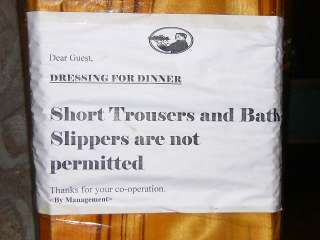
Sign at the entrance of the dining room
To use the rest of the 24 hours for which we had paid and also the lunch at the lodge, we first did an early morning game drive, had breakfast at 8:30, then had to check out of the rooms. We loaded our luggage into the jeep and set out for a second, late morning game drive.
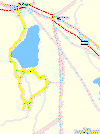
Game drives 14. and 15. May and driving out
The additional, white, diagonal track is still the one of the airliner that had flown us into Kenya.
When we stopped under a tree to watch some rhinos, it suddenly began to rain. But when we looked up, we were under a clear blue sky, and so it took us a while to determine the nature of the rain.
It was a beetle rain. Lots of little borer-like beetles dropped themselves on us from the tree under which we stood. I first feared ticks, but the beetles were obviously no parasites for mammals. My hypothesis is that they drop themselves on large animals to hitch a ride to some other place, and some actually managed to do just that on our jeep.



Pelicans and flamingos at the southwestern shore of Lake Nakuru

A Marabu stork swallowing something
After another very tasty and pleasant lunch meal in the lodge we rushed around the lake to meet our 15 o'clock deadline to avoid having to pay another $100 (3 x $30 plus one student's fee of $10 for my youngest son).
Of course, when you're short of time, you always see the most photogenic scenes and have to stop taking photos. In this case it was a large number of pelicans starting into an updraft and beginning to circle and rise higher and higher.

Pelicans circling in an updraft overhead
We jumped out of the jeep to watch flock after flock coming from the lake and overflying us, then beginning to circle in the updraft above. I won't forget the swooshing sound of the thousand wings.
We continued towards the northern, main gate near the town and calculated that we still had enough time, when we saw the next rare specieseland.
I won't even mention more buffalos and even a few more rhinos on the way. In passing I saw a rock hyrax, then we came to the gate, well in time, and drove off into the town of Nakuru to buy some drinking water.
Then we left Nakuru to the north, in time to reach Baringo before sunset. The road had meanwhile deteriorated quite a bit and was in parts riddled with potholes, so we could not continuously drive our maximum speed of 70 km/h on the tachometer (more like 60 in reality, because the tachometer overreads, which we could easily measure by looking at our GPS) and needed more time. But we still easily made it before sunset.
The additional white track on the left is again the one of the airliner that brought us into Kenya.
Just before Baringo we noticed that the termites were flying. Their spawning is triggered by some unlikely and favorable weather characteristic to make sure all of them in one area swarm exactly at the same time, and that was happening today.
We saw many thousands of termite queens and kings flying and began to look for a termite mound to watch them take off. Soon enough we spotted one. The top of the mound was protected by thousands of ordinary termites, including some soldiers with their fearsomely big heads and mandibles that can easily pierce your thumb and draw blood when you dare to touch them.
And in their midst emerged the four-winged queens and kings, both of the same size and looking pretty much alike, and quickly flying up and away.
Two boys were there to feast on them.
They take one of the departing kings and queens, remove the wings, then tear off the abdomen and eat it, discarding the head and the breast with the legs.
I hear that termites are tasty, though I must admit that I didn't try one. This is just a tad too unfamiliar for me, though I do eat the somewhat similar shrimps.
We kept watching incredible numbers of termites, endlessly coming out of the mound and taking off into the evening sky. Their numbers give you an impression of how large the underground hive must be. The visible mound is only a part of their domicile, more is underneath ground level. That is where they grow their fungus food on a substrate of cellulose, mostly the grass and wood they harvest and carry into the mound. Termites eat about half of the grass in the tropics, leaving less than the other half to all other herbivores. Energetically speaking, they are the most significant species.
Then we went to Roberts Farm, for the first time not into the adjacent Lake Baringo Club, and rented a house there for two nights.
The house had a fascinating architecture and all amenities including mosquito nets. Interestingly, there were not many mosquitos. We were told that the mosquitos appear in much larger numbers after the rainy season ends, but this year Baringo was experiencing lasting rains, which is a rare occurrence. There are years when it doesn't rain at all in Baringo.
We had dinner in the Farm's restaurant, then went to bed and slept under the mosquito nets while the hippos were coming out of the lake and roaming the garden.
Baringo is particularly rich in bird (over 500 species observed) and uncounted insect species. Here's one.
We spent a leisurely day and visited friends. We also planned our next route for tomorrow.
We had already heard that there was a tribal war going on, Pokot raiding Njemps, mainly to the east of Lake Baringo. Our main worry was rampaging groups of people with firearms who might take on the occasional tourist car. But we also heard that a few tourist minibuses had gone through in recent weeks and that the road we wanted to take should not be affected.
Then we heard that a river crossing on one of the roads we needed to take was damaged by water and totally unpassable, because there was no other place to cross the river. Fortunately, after another telephone call to someone living near the affected place, it turned out that that was just slightly outside our route, so we should be able to get through.
So we planned to get up early (5:30) and drive off in the first light of dawn.
And so we did and drove off shortly after 6 o'clock, in the first light of the day before sunrise.
The entire distance took us about 10 hours, including a breakfast in one of the small "hoteli" in Sukuta lol Marmar, which was a kind of omelette on toast. Two of us got the two available knives, the other two had to make do with two forks each.
The tea was very delicious, it was a kind of Indian, sweet cardamom tea with milk, and the omelettes were in fact quite good also. The eggs were absolutely fresh, probably just taken from the hen.
Along the road we met perhaps five other cars, mostly matatus (privately owned public transport minibuses). At one point we had to turn back in front of a deep mud hole and drive a short diversion, but otherwise the track was reasonably good.
On our way we passed through Lodungokwe, where a girl named Anastasia Wangui had repaired my tire last year (see the Kenya 2004 travel report). We had brought a suitcase with clothes for her, sent somebody looking for her, and handed over the suitcase to her delight.
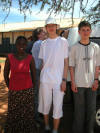
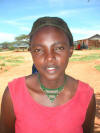
Meeting Anastasia Wangui, the girl who can repair tires
After a few minutes we were on our way again.
When we finally reached the Samburu west gate, we found it open and nobody there, except some women and children, so we waited for a few minutes, then drove through, into the Samburu Game Reserve.
On the remaining distance to Samburu Lodge we met a group of elephants and watched them for a little while, and we saw several gazelles including the tiny dikdiks that we had already seen in Baringo and along the way, and waterbucks.
The lodge was as good and friendly as ever. There were very few other guests, so we got the best rooms, two doubles, each with shower, bathtub, and two beds under a big mosquito net.
In the evening we had the chance to take photographs of some crocodiles.
We didn't meet those in the wild. The truth is that the lodge feeds them in the evening, so they come out of the river and show themselves in their full glory.

How I photographed the crocodiles
Another visitor, this time right into the dining room, is a genet cat, one of the most graceful animals I know.
We spent some leisurely days in the Samburu Lodge, usually doing game drives in the early morning before breakfast and in the late afternoon, sometimes also in the late morning after breakfast.

Samburu and Buffalo Springs game drive tracks
Samburu photo gallery:


Driving out of the lodge with the open roof hatch; game driving with the help of
the GPS receiver

Elephants in front of a tropical rain



More elephants in and near Samburu River


Insects swarming in front of a lamp in the Samburu Lodge; a game of go on the pavilion
overlooking Samburu River

Impala coming to drink from the river, grey herons in the foreground
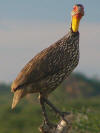
A yellow-necked spur fowl cock reenforcing his territory with a call in the evening



Crested cranes; Ostrich; bustard (German name: Riesentrappe)
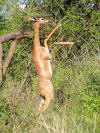
A gerenuk (German name: Giraffengazelle), eating eaves from a bush
One evening when it was already almost dark we came back from a game drive and met another jeep on the way back. They told us they had just seen a lion. Since it is impossible to describe the way back and actually find the lion, they were friendly enough to turn back and lead us there. Even that was difficult, in spite of a GPS in their jeep, but after already giving up and turning back they did eventually find him. Thanks a lot for this wonderful assistance!
We met them again in a far corner of Samburu, and I gave them the web address of this page. Meanwhile we're in email contact again. Here's the lion:

A young male lion eating a gerenuk
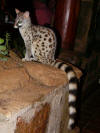
Genet cat in the lodge compound

Elephant bull with the magnificent Mt. Kenya in the background

A waterbuck crossing Samburu River
We drove off at 6:00, when it was still dark, into a beautiful African sunrise and made it to Nairobi in only 8 hours. We chose the western route around Mt. Kenya, via Nanyuki, rather than the eastern one via Meru and Embu, because we wanted to be in Nairobi early enough to visit Rasul's and Langata Link before office closing time.
We made it easily and even had some spare time to have lunch at the restaurant in the hotel at the waterfalls in Thika, Chania Falls. (A photo of the falls is in the 2003 travel report.)
When we took the car to Rasul's for a minor repair (left rearward-looking mirror a bit too loose), the mechanic looked at the car for a split second, then said, your left front main spring blade is broken.
Then we watched as they replaced the spring blade (one of three blades) in a very short time. One of us remarked that this reminds him of a Formula 1 box stop. Of course they fixed the mirror simultaneously, by replacing it with a new one.
We drove over to the Aero Club, unloaded the jeep, then Georg and I drove on to Langata Link, a small business compound, for our first successful Internet connection. This is how you get to see this page.
The next morning we drove off to Maasai Mara. Because of the immediate traffic jam already quite early in the morning, we had to turn back and drive around Nairobi in the southwest via the Langata and Dagoretti roads, which is actually a quite nice way to get from Wilson Airport to the Naivasha road.
We continued to Mai Mahiu again, but this time turned off to the west, towards Narok.
After refuelling at the Kenol station in Narok, we set out for Maasai Mara and reached Sekenani gate in the early afternoon.
When I tried to use my favorite shortcut to Fig Tree tented camp, I found that the entire area between the Mara Simba and the main Fig Tree tracks was blocked by signs like the following.
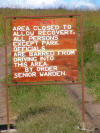
"Area closed to allow recovery. All persons except park officials are barred from
driving into this area. By order senior warden."
After driving all the way to Mara Simba, only to find that the blocked area extends to there, I had to go all the way back to the main Fig Tree track and use that to circumvent the area.
I know this area fairly well. Except for a small stripe near Fig Tree, it is not used much for game drives and has certainly not been overused or damaged. It also doesn't have any unusual track density. The only problem I could see in many years is that the local Maasai regularly drive their cattle herds into it. So I'm wondering what, if anything, is really behind it. The rangers certainly spent quite an effort to have so many signs produced to plaster even the smallest tracks with them. I actually liked to use this area to get to Fig Tree from Sekenani Gate exactly because it was so pristine and little used.
We moved into the tents at Fig Tree and went out for a little game drive in the last hours of the day. I drove out of the lodge and used a path parallel to Talek River towards the west. Not far from the lodge the track was blocked by two cheetahs.
We stopped and watched them for some time, when we all suddenly heard a call I could not identify. The cheetahs both jumped up and briskly walked into the direction of the call, heads high up. We followed them on a parallel track.
After walking for perhaps 200 m, they apparently weren't sure of their direction and distance any more, stopped, and eventually laid down in the high grass.
But after another short time we heard the same call again. The cheetahs jumped up and walked on for a little while. Then, without finding or meeting anything, they stopped and laid down in the grass again.
We staid with them for a little longer, then left them and drove around for a while. At sunset we drove back to the lodge and had a delicious dinner.
We had a good time, usually with two or three game drives a day.
Some photos:

Fig Tree tented camp, almost invisibly laid out in a loop of Talek River
The kids had their experience with that old Kenyan custom of taking little things from the luggage, particularly money. They had some money in purses in their small backpacks, and they went outside without them while a lodge employee was cleaning up in the tent. They came back unexpectedly, and the employee asked them to stay out of the tent for a few minutes until he was finished.
This was their luck. He was apparently frightened enough to put the money back into the purses and the purses back into the backpacks, but since they looked very similar, he mixed them up and put the money back into the wrong purse. The kids, of course, noticed this. One found his purse in an unusual position and missed KSh 10,000, the other had KSh 10,000 too many. I must admit that I found this funny.
Of course I had advised them that money should always be on the body, never unguarded in a tent, but children never believe their parents and have to gather their own experience.
My computer bag was also opened. The guy apparently had no clue that one has to close the zippers in exactly the same way as they were before opening them.
I keep finding these little thefts strange. They guy may take KSh 10,000, or perhaps much less, in the hope that it remains unnoticed, but the fact alone that I report this here can cost the Mada Hotels chain, to which Fig Tree belongs, many times more than that amount, if only a single tourist reads this or hears other complaints and decides to take his business elsewhere.
Not that it would help much, as the same thing apparently goes on in all lodges I know.
On Wednesday I drove along Talek River to check the river crossings. I found both of them unusable. In fact, I didn't even get down to the river in the first place, because the descents were already so washed out that I wasn't sure I would get down and, particularly, back up again. But at least I had a good look at the hippos in the river.
Wednesday afternoon it began to rain, so we skipped our usual evening game drive and stayed in the lodge. The rainy season still seems not to be over just yet. I had to write this report anyway and answer a lot of emails.
Thursday morning we drove out very early and found first a pair of black-bellied bustards (German name: Trappe), then a small pride, actually just a family, father, mother, and two children, of lions.
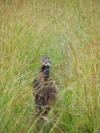
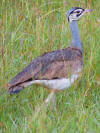
A pair of black-bellied bustards (German name: Trappe) in the grass, covered with
morning dew
This is a very small pride, just two adult lions, and the male still quite young and not yet endowed with the typical large mane of older males.
When they walk around in an area where larger prides reside, they have to keep their heads down, don't make any territory calls, and hope for the best. If a large pride discovered them in their territory, they would pursue them and most likely kill at least the two cubs that cannot run fast enough yet.
Once the two cubs are grown up, if they make it, the pride would then comprise four adult lions and perhaps be able to defend a territory of their own.
On our last full day in Maasai Mara we tried, after the early morning game drive and after breakfast, to reach another game drive area in the southeast, near Keekorok, but we got into a water trap and lost too much time. The trap was that we had to turn back because of unpassable creeks and drive a long way back to get out of the area.
We also found that the area near our lodge had an incomparably higher density of all kinds of wild animals, so we decided to do our evening game drive right there again, within minutes of the lodge.
An hour before sunset a huge thunderstorm developed in the west and slowly spread out towards us, so we eventually drove back to the lodge, fleeing from the first raindrops. Some photos:

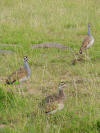

Hyaena hiding under a bush; a black-bellied bustard family; buffalos

Family at tea time in Fig Tree Tented Camp
It kept raining through much of the night and also the following day, making our return to Nairobi a little more difficult.
We left after an early breakfast and tried to make it through the most difficult part, the first kilometer out of the lodge.
After we had already made it to the main track towards Keekorok, before the branch to Sekenani Gate, we encountered a very slippery, curved stretch of road where most of the gravel, that had been put there to make the track rain-proof, had alredy gone to the sides and disappeared into the deep mud. It is called black cotton soil, and its consistency is almost unimaginable before you've actually encountered it.
When dry, it is hard and tends to crumble. But when it is wet, it becomes a clay-like, slippery, but also sticky stuff on which a car can slide like on wet soap.
The track had been graded some time ago and had a convex cross-section, allowing the water to run off in two deep ditches on either side. We drove in the middle, on the top, and here I made a mistake or perhaps two. One was that I tried to avoid the car track in the middle, because it looked already somewhat deep and muddy. The other, more critical one was that I drove slightly too fast, closer to 30 km/h than 20 km/h (closer to 19 mph than 12 mph). Speed and momentum helps to get you through a lot of mud, but as I would now learn, it has its drawbacks and has to be applied with good measure.
At one point in the gentle left curve the jeep's rear slipped to the right. I compensated by steering such that the front wheels kept going properly along the top, hoping that the rear wheels would sooner or later encounter some grip and come back in line, but the soil was so slippery that the rear kept swerving to the right until I hit the right stop of the steering. I could no longer compensate, and the front wheels went off the track to the left side.
At that time the rear wheels did hit some resistance and did come back in line, as I had hoped, but it was already too late. The left front wheel had by now gone into the left ditch, and the left rear wheel followed suit. We were stuck.
I tried to gently move the car backward and forward to create a short trail where we could accelerate enough to get out. It turned out that we could keep driving very slowly, by letting the wheels dig in until they hit harder ground at a depth of approximately 30 cm (12 inches) in the mud. I created a track of several meters in length, then went all the way back, then gently accelerated forward.
This worked pretty well. I steered to the right to get back to the top of the track, but when the front wheels were already out of the ditch and moving well in the right direction, they lost grip again and slid back to the left into the ditch.
I guess it would have been possible to get out that way by retrying until we hit some harder ground or some more stones in the mud, but at this time another jeep overtook us and towed us out. We attached our tow rope to both jeeps, and recovery took only a few seconds.
Thanks to the two people who helped us! [If you happen to read this, please send me an email!]
At least it was a useful experience, and it led me to add a chapter on wet tracks to the jeep driving tutorial. It is also another example showing that the four-wheel-drive is far from solving all driving problems.
The following photo was taken later, outside of the nature reserve.
It is an example for a situation where you have to stop and take a few minutes to plan every movement of the passage through the entire problem range, before you actually do it.
We arrived at the Aero Club in the afternoon, settled into the guest rooms and had a good dinner.
The local flight times were Nairobi 10:00 18:10 Amsterdam Schiphol 20:30 21:55 Munich.
After a last breakfast in the Aero Club we drove to the international airport and, fortunately, found that we had hit a relatively quiet time, so the lines were not too long. And so the family boarded the plane and flew back to Germany.
I spent the afternoon in the Aero Club, strolled over the airfield, met a few people including the Chief Flying Instructor of Pegasus Flyers (the flying branch of the Aero Club) and had a generally leisurely day.
Had to arrange various things, mainly extend my Kenyan pilot license and plan the rest of my stay. I also visited Rasul's, had the car checked and cleaned once again, and went to Langata Link to upload this web page.
On my way I saw this bus and had to take a photo for my friends in and around Microsoft.

Microsoft Angelthe text on the side says, "Safari Njema" ("Have a good trip")
I went to bed early and woke up early to a wonderful morning with almost entirely clear blue sky and cool, fresh air. I took my breakfast on the open terrace of the Aero Club, watching the early morning planes take off, and enjoyed the atmosphere. At times the whole airport was eerily quiet, the silence being interrupted only by the calls of some ibises.
Later in the morning I tried to solve an emergency at the elephant projecta desktop computer was no longer booting beyond the first boot menu. I had it brought to the Langata Link office, where there is also a small computer company that I hoped would be able to help me out by providing a computer for a short time and the required tools to take the computer apart.
The experience I gathered there is indescribable, but I'll try nonetheless to give a few impressions.
First it was difficult to enter the workshop, because the place was so full of all kinds of computers, computer parts, and people that I had to watch my steps very carefully not to step on anything. Making room on a desk to be able to put the computer there was a major undertaking.
Then it took about 10 minutes to find a screwdriver.
Then it took about 20 minutes to switch the computer on. Not the problem computer that I brought, but their own computer, on which I wanted to repair the damaged hard disk data (by running CHKDSK).
As the computer booted, it showed a series of virus warnings, almost prompting me to call everything off, but the repairman assured me that the virus is inactive. When I asked why he hadn't removed the offending infected files, he told me that this is difficult, as the virus prevents it. How it does that while not being active is beyond me. I can only hope that I can remove the virus from our disk, should it jump over.
This experience is typical of the old Africa that I've known for many years. However, there is also a new Africa, one where things work much better. I know another computer shop that impresses me much more positively. But it is in town, too far from here.
Enough of this for now. I made a plan to drive to Amboseli, at the foot of Mt. Kilimanjaro tomorrow morning.
I had another early, but nice breakfast at 6:30, then drove out of the Aero Club down the Mombasa Road to Athi River, then through Kajiado, Il Bisil and Namanga.
In Il Bisil I saw an ostrich in the middle of the town, which keeps surprising me. But they have domesticated ostriches there, as well as in other places in Kenya. Apparently ostriches can be tamed quite well and can be herded and used for meat.

Domesticated ostrich in Il Bisil
As expected, the track from Namanga to Amboseli, which had just been graded and had been very good in 2004, had meanwhile deteriorated considerably under rain and car tires, but it was still possible to drive most of it at 50-70 km/h, so I arrived in Amboseli not long after noon and was greeted by the peak of Kilimanjaro briefly peeping out between the clouds. The following photograph was taken later in the afternoon.

Zebras in front of Kilimanjaro
After dark I looked into the sky and saw the Milky Way as we can never see it back home. Here the night is really pitch dark, the air is clean, clear, and thin due to the altitude, and no artificial light spoils the magnificent sight.
This is the home of the Amboseli Elephant Research Project (see www.elephanttrust.org), and I regularly spend some time here to assist the project, partly by working on the computer database that holds over 30 years of observation records.
This time I also began with the database work, so there was not much to write, but between working spells I did some game drives and took some photographs.
The following picture is very similar to one in an earlier travel report, but it shows the thatched roof extension keeping the tent cool.
I often drove out for game drives.
As usual I fed my electronic equipment, i.e. the computer and various battery chargers, through an inverter from the solar battery in the tent, and if that ran empty, I used the car battery by driving the car close to the tent and laying a cable.
On Saturday I came back from a drive to Meshenani Gate. I had tried to drive through Lake Amboseli, but about halfway I got worried, because the car began to sink in and required more power to maintain speed, so I veered off and drove closer to the shore of the not so perfectly dry lake bed. On the way back I tried the lake again and found that it was dry on the other side, so I drove entirely through it this time.
Reaching the wet area, the car began to slide sideways, so I engaged the 4-wheel drive and drove on. I also couldn't maintain speed in 5th gear, so I had to shift to lower gears to have enough force. Then the car began splashing mud on its windscreen, but it was still quite possible to continue, and I drove right through the wet area and finally the entire lake.
Reaching the other shore, I saw a cheetah strolling along the perimeter of the lake, but I couldn't get close enough to take a photo, so you have to take my word for it. This was the first cheetah I saw here, and it was an encouraging sight, as many predators had shifted away from the omnipresent Maasai herds and their herders.
When I came back into the camp, I drove backwards past my tent as usual, then positioned the jeep with the battery close to the tent to get electricity. Only after I had parked the jeep and jumped out, I noticed that a lady elephant, Ella, was standing not much more than 10 m away, eating grass.
I tried to tell her that I'm peaceful by imitating an elephant voice, and indeed she continued to come closer. My intention had been to open the hood to get at the car battery, but I delayed that, so as not to do anything unusual that could frighten her. Instead I took the photos above, then went into my tent and watched her graze while I was resting on my bed. She stayed with me for another 15 minutes, then went away to rejoin her group, which I could hear behind the bushes.
Ella is the second in command of the famous elephant family named EB and headed by the movie star Echo. Echo went away a week ago and has been seen near the Tanzanian border with her baby.
Walking through the high grass here in Amboseli carries some risks, one of them ticks. On the left straw you see perhaps a thousand pepper ticks, which are smaller than 1 mm and difficult to spot as individuals. The right picture shows both adult ticks and pepper ticks, which are the larvae or nymphs of the bigger ticks, not any separate species.


Pepper ticks; both adult and pepper ticks
The ticks apparently have the ability to seek out single straws that stand out from the edge of a path and gather there.
For more information on ticks please see this WHO page.
Pictures from another game drive:
Sunday evening I wanted to go out for a game drive, but my girl-friend Ella came visit again and this time brought her whole family along. First I sat in front of the tent, watching the elephants move into the swamp right in front of me.
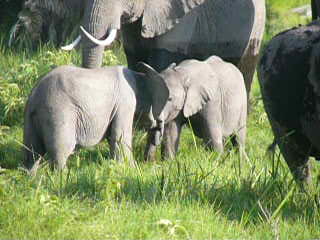
Attack and revenge (WMV video, 00:00:29, 1.11 MB)
Then, however, when the first youngsters came within 15 m and another elephant nibbled on the bush beside the tent, I thought I'd better move inside. Then I couldn't leave my tent any more, as you can see from the following photos and the movie.
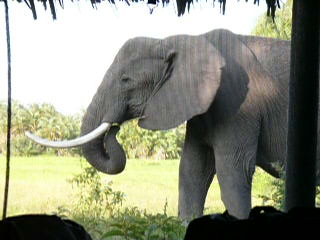
Ella and son next to my tent (WMV video, 00:04:37, 4.49 MB)
I spent the whole evening until sunset with the elephants at my tent, so there was no need to drive out. It was fascinating to have the big animals so near. I talked to them from time to time to make sure they really knew that I am there. I didn't want any surprises. But they know the camp and are used to it.
During the following days I worked on the computers, making database changes, and also on the solar system of the camp. In between, usually in the early morning or in the evening before sunset, I drove out, resulting in the following little photo gallery.



Elephants: Mother with children; bull; mother with child

Pelicans
[Panorama picture created with Autostitch]

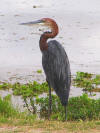

Spoonbill stork and unknown heron; Goliath heron; unknown heron again with elephants


Spur wing goose; crowned crane in flight
The following two pictures were taken in the research camp kitchen in the evening. Josphat is the new research camp assistant and in charge while Peter is on holiday, David is a research assistant.

Josphat and David in the research camp kitchen

A mouse or a small rat stealing ugali (a Kenyan staple foodmaize meal boiled in
water) from the camp kitchen
More wildlife photos:



A crowned crane family; elephant bull; zebras drinking
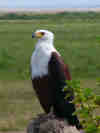
Fish eagle (German name: Seeadler)
Since I wanted to meet several people before departing, I drove off very early, at sunrise, but I still drove around to the big swamp to take a few last photos. This plan was rewarded by seeing the cheetah again that I had seen the day before.
Then I drove right through Lake Amboseli, which had been wet and barely drivable with 4-wheel drive engaged a week ago, but was now almost totally dry. I saw zebras, as well as their bones.

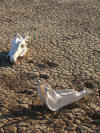
Zebras crossing Lake Amboseli; zebra skull and jaw
Finally I passed the gate and drove back to Namanga on this wonderful sunny morning, taking a few more photos of the mountain along the way.
The local flight times are Nairobi 10:05 18:10 Amsterdam Schiphol 20:30 21:55 Munich. Shahid Rasul accompanied me to the airport, where I turned the jeep back over to him. On the way I took one last photo:
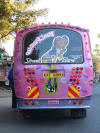
Matatu, the lights are actually moving in a flowing pattern
The seat booking I had done with KLM didn't make it through to Kenya Airways, which turned out to actually conduct the flight in the dreaded code sharing fashion. So no GPS route this time, but it's about the same route as on the flight to Nairobi.
The connecting flight from Amsterdam to Munich was delayed by 15 minutes, not to mention a gate change that hits me just after I've walked the kilometer-long distance to the originally planned gate. Oh well, these are the joys of airline travel. I still had the time to write these lines on my laptop while waiting for the plane to get ready for boarding.
And so another great time in Kenya ended. I cannot wait to get back there and already have plans for a bigger safari next year, in the first two weeks of June 2006. If you would like to join in, please send me an email.

Ostrich at sunset
If in this text you find any typos, orthographic errors (even small ones), ungrammatical sentences, wrong or illogical information (like wrong names of birds), if you want me to write more details about something in particular, or if you want one of the photos in full resolution (usually 1,600 x 1,200 pixels), please click on the email sign below and write to me. Many thanks!
Copyright 2005-2023 Hans-Georg Michna.
Private homepage – Hans-Georg Michna
Kenya travel reports: 1999, 2000, 2002, 2003, 2004, 2005, 2006, 2007, 2008, 2009, 2010, 2011, 2012, 2013-Goma, 2013, 2014, 2015, 2016, 2017, 2018, 2019
Kenya Safari Travel Plan, Kenya 1980-2000 photos
hits since 2007-11-01
Free PHP scripts by PHPJunkYard.com